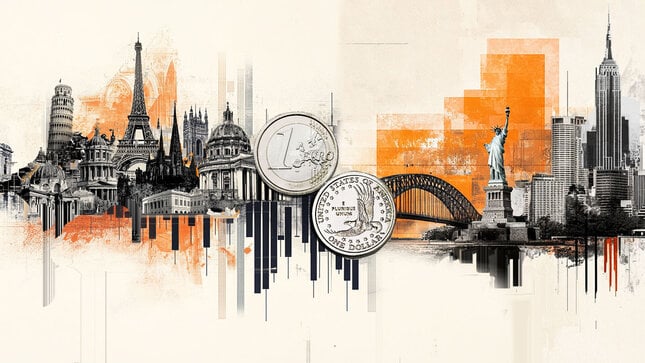USD/CHF Exchange rate
Editors’ Picks

EUR/USD turns positive, approaches 1.1700
EUR/USD now manages to regain balance and approaches the 1.1700 barrier as the US Dollar appears under sudden downside pressure. The pair, in the meantime, reverses initial losses as investors continue to assess the latest US PCE data and factor in expectations of a rate cut by the Federal Reserve at its September 17 meeting.

GBP/USD bounces off two-day lows, focus back to 1.3500
GBP/USD comes under renewed downside pressure at the end of the week, navigating the 1.3470 region against the backdrop of a modest resurgence of the buying interest in the Greenback. US inflation tracked by the PCE matched consensus in July, opening the door to a rate reduction by the Fed next month.

Gold approaches four-month highs near $3,450
Gold keeps its march north well and sound, up for the fourth day in a row on Friday, and challenging multi-month peaks near the $3,450 mark per troy ounce on the back of steady bets for a rate cut by the Federal Reserve in September. The likelihood of further easing by the Fed appears propped up by the eaerlier release of US inflation data, this time measured by the PCE.

Bitcoin sell-off sends jitters across the market, Ethereum, XRP wobble
Cryptocurrencies remain under pressure on Friday, reflecting risk-off sentiment ahead of September. Attempts to sustain Bitcoin (BTC) price recovery have consistently failed, with Bitcoin trading below $110,000 at the time of writing.

All eyes on NFP report as Fed rate cut bets intensify
Will August jobs report shock again? It’s almost one month ago that the July payrolls numbers generated not just considerable volatility in the markets but also a lot of controversy, as it offended President Trump’s record on the economy.
Majors
Cryptocurrencies
Signatures
USD/CHF
Commonly referred to as the Swissie, the pair reflects how many Swiss
Francs
(CHF) are needed to purchase one US Dollar (USD). Both currencies are traditionally considered
safe-haven
assets. During times of uncertainty, the Swiss Franc tends to remain stable or appreciate
against its
European counterparts.
The USD/CHF pair typically has a negative correlation with the
EUR/USD and
GBP/USD currency pairs. This is due to the positive correlation shared by the Euro, Swiss Franc
and British
Pound.
To curb the excessive appreciation of the Swiss Franc and its potential negative
impact on Swiss exports during the global financial crisis, the Swiss National Bank implemented
a currency
peg at CHF 1.20 per EUR in 2011. However, since the SNB removed the currency peg in January
2015, the CHF
has partially lost attractiveness in turmoil times, with speculative interest more inclined
toward the
Japanese Yen (JPY) or Gold.
HISTORIC HIGHS AND LOWS FOR USD/CHF
- All-time records: Max: 4.3076 on 4/01/1971 – Min: 0.7069 on 8/08/2011
- Last 5 years: Max: 1.0147 on 14/10/2022 – Min: 0.8332 on 22/12/2023
* Data as of December 2024
ASSETS THAT INFLUENCE USD/CHF THE MOST
- Currencies: Particularly the Euro and the Japanese Yen due to their significance as commercial partners.
INFLUENTIAL ORGANIZATIONS FOR USD/CHF
- The Swiss National Bank: The SNB is Switzerland’s central bank, responsible for the country’s monetary policy and the sole issuer of Swiss Franc banknotes. Its primary objective is to ensure price stability while considering economic developments, thereby fostering an environment conducive to economic growth. To ensure price stability, the SNB aims to maintain appropriate monetary conditions, which are determined by the interest rate level and exchange rates. For the SNB, price stability means a rise in the Swiss Consumer Price Index (CPI) of less than 2% per year. Martin Schlegel is Chairman of the Governing Board of the SNB.
- The Federal Reserve of the United States (Fed), whose chairman is Jerome Powell . It is the central bank of the US and it has two main targets: to maintain the unemployment rate at its lowest possible levels and to keep inflation around 2%. The Federal Reserve System's structure is composed of the presidentially appointed Board of Governors and the partially appointed Federal Open Market Committee (FOMC). The FOMC organizes eight scheduled meetings in a year to review economic and financial conditions. It also determines the appropriate stance of monetary policy and assesses the risks to its long-run goals of price stability and sustainable economic growth.
- The European Central Bank : The ECB i s the central bank empowered to manage monetary policy for the Eurozone. The ECB’s mandate is to maintain price stability in the Eurozone, so that the Euro’s (EUR) purchasing power is not eroded by inflation. Christine Lagarde has been the President of the ECB since November 1, 2019. The ECB significantly influences the Swiss Franc due to the strong trade and business ties between the Eurozone and Switzerland.
- The Bank for International Settlements (BIS): Based in Basel, Switzerland, the BIS is an international financial institution owned by central banks. It fosters international monetary and financial cooperation while providing banking services exclusively to central banks and other international organizations.
- The Swiss Financial Market Supervisory Authority (FINMA): As the state regulatory authority, FINMA oversees banks, insurance companies, stock exchanges, securities dealers, and collective investment schemes, ensuring the stability and integrity of Switzerland's financial markets.
- The SIX Swiss Exchange: Based in Zurich, it is Switzerland's principal stock exchange.